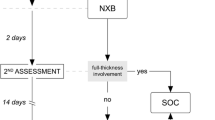Abstract
Purpose
Hand burns are common in the pediatric population. Optimal hand function is a crucial component of a high-quality survival after burn injury. This can only be achieved with a coordinated approach to the injuries. The aim of this study was to review the management algorithm and outcomes of pediatric hand burns at our institution.
Methods
In total, 70 children fulfilling our study criteria were treated for a burn hand injury in our Burn Care Center between January 2008 and May 2013.
Results
14 of the 70 pediatric patients underwent surgery because of the depth of the hand burns. The management algorithm depending on the depth of the burn is described. Two patients underwent correction surgery due to burn contractures later.
Conclusion
For a successful outcome of the burned hand, the interdisciplinary involvement and cooperation of the plastic and pediatric surgeon, hand therapist, burn team, patient and their parents are crucial.




Similar content being viewed by others
References
Feldmann ME, Evans J, Seung-Jun O (2008) Early management of the burned pediatric hand. J Craniofac Surg 19:942–950
Clarke HM, Wittpenn GP, McLeod AM et al (1990) Acute management of pediatric hand burns. Hand Clin 6:221–232
Kamolz LP, Kitzinger HB, Karle B et al (2009) The treatment of hand burns. Burns 35:327–337
Sheridan RL, Baryza MJ, Pessina MA et al (1999) Acute hand burns in children: management and long-term outcome based on a 10-year experience with 698 injured hands. Ann Surg 229:558–564
DAV Leitlinien: http://www.awmf.org/uploads/tx_szleitlinien/044-001l_S1_Thermische_und_Chemische_Verletzungen.pdf
Monstrey S, Hoeksema H, Verbelen J et al (2008) Assessment of burn depth and burn wound healing potential. Burns 34:761–769
McKee DM (2010) Acute management of burn injuries to the hand and upper extremity. J Hand Surg 35:1542–1544
Barret JP, Desai MH, Herndon DN (2000) The isolated burned palm in children: epidemiology and long-term sequelae. Plast Reconstr Surg 105:949–952
Chung KC, Smith DJ (1998) Jr. New trends in hand burn. Tech Hand Up Extrem Surg 2:278–283
Kreymerman PA, Andres LA, Lucas HD et al (2011) Reconstruction of the burned hand. Plast Reconstr Surg 127:752–759
Conflict of interest
No conflict of interest.
Author information
Authors and Affiliations
Corresponding author
Rights and permissions
About this article
Cite this article
Liodaki, E., Kisch, T., Mauss, K.L. et al. Management of pediatric hand burns. Pediatr Surg Int 31, 397–401 (2015). https://doi.org/10.1007/s00383-015-3674-3
Accepted:
Published:
Issue Date:
DOI: https://doi.org/10.1007/s00383-015-3674-3




